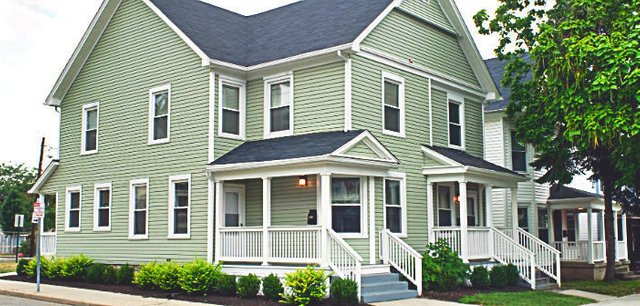
The quickest way to wealth in real estate is to purchase a property in an emerging market during one of the early phases of the market cycle. In this article, it is my objective to describe the four phases of the real estate market and how you can make money while purchasing in these four phases. I will also dive into our criteria for buying a multifamily propertyand how you can limit your downside risk.Let’s jump into the four phases.
Phase 1: Recovery
The characteristics in this market phase include declining vacancy and no new construction. In my opinion, this is where the savvy investor looks to buy. Unfortunately, securing financing during this phase can be difficult, and overall sentiment is still weak. This marks the contrarian phase in my estimation, where value investors jump in by buying at low prices.Most investors have been snake bitten from the recession and are unwilling or unable to buy in this phase. The majority of the real estate markets have emerged from this phase and find themselves in the expansion phase.
Phase 2: Expansion
Many markets find themselves entrenched in the expansion phase, a time of declining vacancy and new construction. It takes a few years for new inventory to come online, and during this period, rents and occupancy both expand. In 2015, rent growth was a robust 5.6%, and occupancy stood at 96.1% — both highs. You may be thinking, “Here we go again!”Let me tell you why you should still consider investing in multifamily assets if they can be purchased at reasonable values. We have been transitioning to a renter nation, with the aid of a shift in demographics and the Great Recession. Homebuyers are still feeling the ill effects of purchasing a home and getting hammered. There is no guarantee that buying a home and holding on for the long-term will produce any gains. The economy plays a huge role in the expansion phase, and the economy is currently adding jobs to the markets we are invested in.Two demographics that tend to rent are Millennials and Baby Boomers. Every seven seconds, a person turns sixty in the United States, which creates more demand for our apartments. Millennials are entering the labor force saddled with student debt and are forced to rent, which creates another pool of prospective tenants. This demand has been fueling rent growth and is one of the main reasons why property values will continue to increase.

Related: The Real Estate Market: How to Analyze and Predict Cycles
Phase 3: Hyper-Supply
Trouble is brewing on the horizon in this phase. Vacancy begins to increase, and new construction is still ramping up. This is a period when builders need to recognize what is occurring and should put the brakes on new construction. The party is starting to come to an end, but I would still buy in this cycle if I find a deal that fits my parameters: 10% cash on cash return, 8 cap, and a 1.3 debt coverage ratio.Deals are harder to come by in this phase, but we are still actively pursuing them. It’s all about the numbers, and we buy on ACTUAL numbers, analyzing the last twelve months of a property’s profit and loss statement.
Phase 4: Recession
Anyone remember 2008? The vacancy rate was increasing, and new completions were being delivered to the market. The new construction came to a halt, but it was too late. There was a double whammy — less renters with the addition of new inventory. Rental rates, as well as occupancy, continued to plummet, and this accelerated the downturn in real estate values.Let’s turn our attention to underwriting these deals and how you can “buy right.” The first step to buying right is to analyze a deal based on actual numbers. Ask the broker for the last 12 months of trailing profit and loss figures. If the broker can’t provide you with a profit and loss, either move onto the next deal OR try to obtain the last three months of gross income.Next, I will create an estimate of what the expenses should be and perform a rudimentary analysis based on these estimates. I know in my market, it costs me around $3,600 per unit to run a property, and investors need to learn how much it costs to run a property in their market. I have also used the rule of thumb for operating expenses as 50% of gross income to perform a quick calculation. For example, if a property is grossing $10,000 per month, I will estimate expenses to be around $5,000.Once I have calculated income and expenses, I arrive at the net operating income (NOI) by subtracting income by expenses. Visit our previous article on BiggerPockets that discussed how to calculate value using the net operating income.I focus on three criteria when investing in multifamily assets.
Cash on Cash Return
I expect to earn at least a 10% cash on cash (COC) return from day one. As we progress further into the expansion phase, it has become increasingly difficult to find deals that produce this return, but I maintain my discipline and will not purchase an asset that is not producing an actual 10% COC. Be prepared to analyze a lot more deals.My biggest mistakes in real estate were all centered on the buying phase. I either overestimated the appreciation of the property or I fell in love with the property. I quickly learned that all savvy investors make their money on the purchase of the asset. Buying with an actual 10% COC limits my downside risk, and any forced appreciation that occurs on the property will become my profit.
Debt Coverage Ratio
I aim for a 1.3 Debt Coverage Ratio (DCR). To calculate DCR, take the NOI and divide it by the annual debt. Banks typically require at least a 1.2 DCR to lend on a property. A property that achieves a 1.2 DCR is simply generating 20% more income than the payment of the debt.

Related: 3 Simple Steps to Increase the Value of Your Multifamily Property
Cap Rates
As the market continues to appreciate throughout the United States, we have been witnessing a compression of cap rates. Simply put, values increase, and cap rates drop. In our market, we aim to purchase a C-asset with an 8 cap. I know most readers will find it incredulous that there are still properties out there trading at an 8 cap. If I can’t buy at an 8 cap, then I will pass on the deal unlessthere are incredible value adds with the property that will allow me to explode the NOI of the asset.Consistency in the buying process will allow you to analyze deals quicker and become more accurate in your underwriting. Emotion will be removed from the buying process, and the numbers become the focal point. Don’t commit my mistake of falling in love with a deal. Fall in love with the numbers first.
Your Task
Decide what market to invest in, and begin to research the market. Focus on job growth, which should average at least 2% growth for two consecutive years. To access data for jobs in a market, Google the name of the city and “job growth” or utilize the website www.bls.gov to gather employment data for a specific city. Look for companies announcing a move to a market, and become familiar with employers in your market.Target markets that are experiencing household and population growth. Household growth is a more powerful barometer because households are the ones that become our clients.Study the demographics of the market and look for a higher percentage of Millennials and Baby Boomers. The middle aged demographic tends to have families and are more apt to become homeowners.Finally, take action and educate yourself on the power of multifamily investing. A wise man once told me, “It’s not what you buy, but what you pay.”[Editor’s Note: We are republishing this article to help out our newer readers.]I want to know what’s going on in your market. Please leave me a comment and tell me where cap rates are in your market and where you are finding deals! I know they’re out there, it’s just much harder to find them.
Hi! I am a robot. I just upvoted you! I found similar content that readers might be interested in:
https://www.biggerpockets.com/renewsblog/2016/06/09/real-estate-cycle-multifamily/
Downvoting a post can decrease pending rewards and make it less visible. Common reasons:
Submit
don't buy a thing, the world is about to crash.
Downvoting a post can decrease pending rewards and make it less visible. Common reasons:
Submit
Congratulations @biggerpockets! You have completed some achievement on Steemit and have been rewarded with new badge(s) :
Click on any badge to view your own Board of Honor on SteemitBoard.
For more information about SteemitBoard, click here
If you no longer want to receive notifications, reply to this comment with the word
STOPDownvoting a post can decrease pending rewards and make it less visible. Common reasons:
Submit
Congratulations @biggerpockets! You received a personal award!
You can view your badges on your Steem Board and compare to others on the Steem Ranking
Do not miss the last post from @steemitboard:
Vote for @Steemitboard as a witness to get one more award and increased upvotes!
Downvoting a post can decrease pending rewards and make it less visible. Common reasons:
Submit